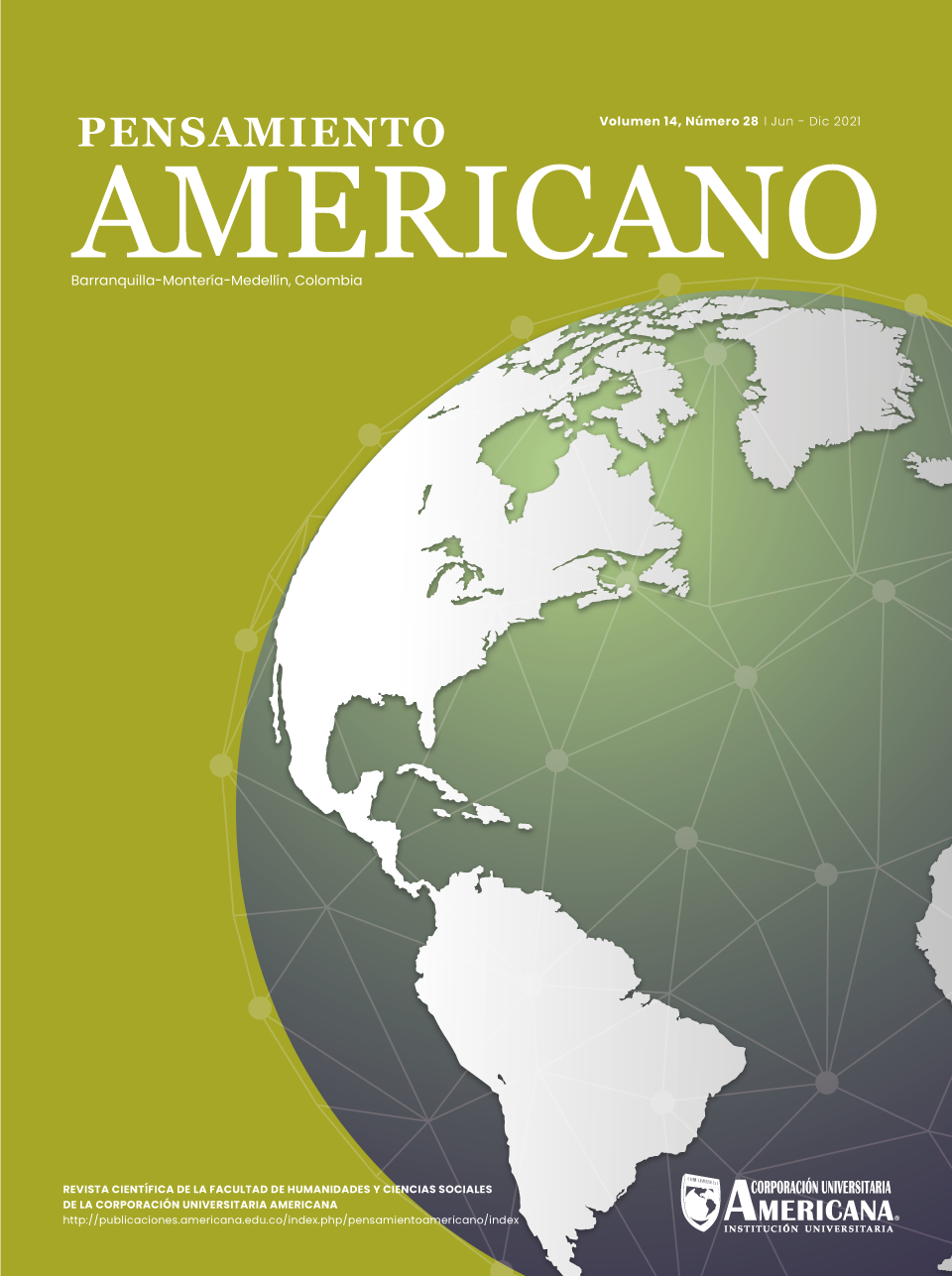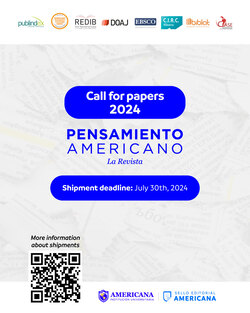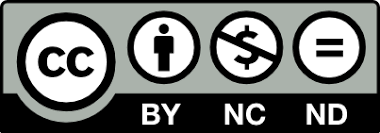Los textos de geometría: una mirada diferente para nuestros tiempos
DOI:
https://doi.org/10.21803/penamer.14.28.382Palavras-chave:
Secuencia didáctica, Escuela Nueva, Pensamiento numéricoResumo
Introducción: La función de los libros de texto como recurso didáctico y el impacto que tienen éstos sobre la educación matemática, en particular de la geometría, hace que resulte pertinente la realización de análisis de tipo hermenéutico y crítico sobre las características y adaptaciones a la realidad actual colombiana. Objetivo: La presente investigación busca estudiar los textos escolares de matemática, en los que encontramos inmersa la temática de la geometría, a través de la observación de la estructura que utilizan, de tal manera que se verifique si contribuyen a la generación de un aprendizaje significativo en el estudiantado, y no simplemente se convierten
en una continuación de las clases. Método y/o metodología: Se trabajó un diseño de análisis
de contenido como técnica para la descripción objetiva, sistemática y cualitativa del contenido manifiesto de las comunicaciones, con el fin de interpretarla. Los resultados más relevantes muestran la necesidad de que los textos escolares le apunten a textos digitales donde se enfoque
a la resolución de las deficiencias presentadas en los textos actuales. Conclusión: a través de la digitalización de los textos de geometría se puede contribuir a la mejora de la visualizaciónmediante entornos interactivos y dinámicos de contenidos más asertivos en el área.
Downloads
Referências
Abela, J. (2002). Las técnicas de análisis de contenido: una revisión actualizada. Fundación Centro de Estudios Andaluces.
http://public.centrodeestudiosandaluces.es/pdfs/S200103.pdf
Berelson, B. (1952). Content analysis in communication research. Free Press, Glencoe. https://psycnet.apa.org/record/1953-07730-000
Cantoral, R., Montiel, G. & Reyes-Gasperini, D. (2015). Análisis del discurso Matemático Escolar en los libros de texto, una mirada desde la Teoría Socioepestemológica. Avances de Investigación en Educación Matemática, 8, 9 – 28. https://doi.org/10.35763/aiem.v1i8.123
Chevallard, Y., & Johsua, M. (1982). Un exemple d’analyse de la transposition didactique: la notion de distance. Recherches En Didactique Des Mathématiques Grenoble, 3(2), 159–239. https://publimath.univ-irem.fr/biblio/AAR99089.htm
Emmanuele, D., González, M. I., Introcaso, B. & Braccialarghe, D. (2010). Análisis de libros de cálculo en carreras de ingeniería:
Su relación con los cambios sociopolíticos en Argentina. Educación matemática, 22(2), 35-63. http://www.scielo.org.mx/scielo.php?script=sci_arttext&pid=S1665-58262010000200003
Espinoza, R. F., Pochulu, M. D. & Jorge, M. J. (2013). El análisis didáctico de textos escolares ¿qué herramientas proveen las diferentes líneas y enfoques en Educación Matemática? http://funes.uniandes.edu.co/18967/
Etchegaray, S. (2001). Análisis de significado personales e institucionales: El problema de su compatibilización. En M. F. Moreno, F. Gil, M. Socas y J. Godino, (Eds.), Quinto Simposio de la Sociedad Española de Investigación en Educación Matemática (pp. 159–168). Almería: Servicio de Publicaciones. https://www.seiem.es/pub/actas/index.shtml
García, G. (1996). Reformas en la enseñanza de las matemáticas escolares: perspectivas para su desarrollo. Revista EMA, 1(3), 195–206. http://funes.uniandes.edu.co/1025/
Godino, J., Wilhelmi, M. & Font, V. (2006). Análisis ontosemiótico de una lección sobre la suma y la resta. RELIME. Revista latinoamericana de investigación en matemática educativa, 9(1), 131-156. http://relime.org/index.php/
Howson, G. (1995). TIMSS monograph No. 3: Mathematics textbooks: A comparative study of grade 8 texts. Pacific Educational Press.
Love, E., & Pimm, D. (1996). “This is so”: A text on texts. En A. J. Bishop, K. Clements, C. Keitel, J. Kilpatrick, & C. Laborde (Eds.), International handbook of mathematics education (pp. 371-410). Dordrecht, The Netherlands: Kluwer Academic Publishers.
Otte, M. (1997). What is a text? En Christiansen, B., How-son, A.G., Otte, M. (eds). Perspectives on mathematics education, (pp. 173-203). Springer, Dordrecht: D. Reidel Publishing Company. https://doi.org/10.1007/978-94-009-4504-3
Pimm, D. (1987). Speaking mathematically. Nueva York: Routledge y Kegan Paul. Trad. cast. (1990). El lenguaje matemático en el aula. Ministerio de Educación y Ciencia - Ediciones Morata.
Pimm, D., & Keynes, M. (1994). Mathematics classroom language: Form, function and force. In R. Biehler, R. Scholz, R. Sträßer, & B. Winkelmann (Eds.), Didactics of Mathematics as a Scientific Discipline (pp. 159–169). Kluwer Academic Publishers. https://www.researchgate.net/
Radford, L. (1997). On psychology, historical epistemology, and the teaching of mathematics: Towards a socio-cultural history of mathematics. For the Learning of Mathematics 17(1), 26-33. http://www.jstor.org/stable/40248219
Rodríguez, F. M., Basso, A. & Garcia Gonzalez, M. D. S. (2019). El análisis de textos como metodología de investigación
en educación matemática. http://ri.uagro.mx/handle/uagro/2703
Schubring, G. (1987). On the methodology of analysing historical textbooks: Lacroix as textbook author. For the learning of mathematics, 7(3), 41-51. https://flm-journal.org/
Van Dormolen, J. (1986). Textual analysis. In Christiansen B., Howson A.G., Otte M. (eds) Perspectives on mathematics
education (pp. 141-171). https://doi.org/10.1007/978-94-009-4504-3_4
Downloads
Publicado
Versões
- 2021-12-30 (3)
- 2024-05-31 (2)
- 2021-12-30 (1)
Edição
Seção
Licença
Copyright (c) 2021 Pensamiento Americano

Este trabalho está licenciado sob uma licença Creative Commons Attribution-NonCommercial-NoDerivatives 4.0 International License.
The author or authors of an article accepted for publication in the Journal Pensamiento Americano will transfer all of the patrimonial rights to the American University Corporation free of charge, within which are included: the right to edit, publish, reproduce and distribute both print media as digital, in addition to include in article in international indexes and / or databases, likewise, the Editorial Seal is authorized to use the images, tables and / or any graphic material presented in the article for the design of covers or posters from the same magazine. By assuming the patrimonial rights of the article, it may not be partially or totally reproduced in any printed or digital media without its express permission.
AUTHORITY ASPECTS
For the Pensamiento Americano Journal, all the authors of an article have made substantial contributions to the research and the manuscript, and they share the responsibility when the article presents errors, fraud in some way or violations of copyright.
After submitting an article, the journal does not accept the addition, deletion or change in the order of the authors, in addition we reserve the right to release the article when it has been submitted to the journal and under no circumstances will American Thought accept the article. withdrawal of an article during any phase of the editorial process






